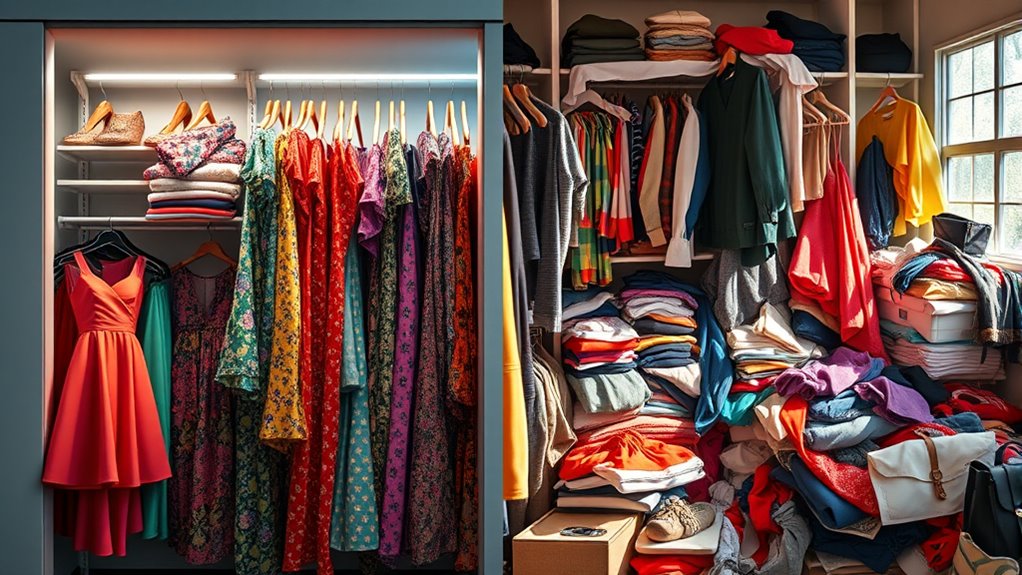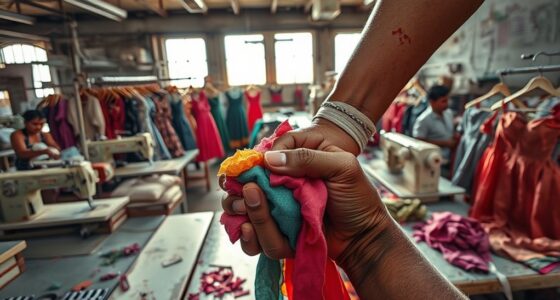In 2025, renting clothes is generally greener than buying because it reduces textile waste, promotes sustainable fabrics like organic cotton and recycled fibers, and encourages a circular fashion economy. Renting lets you enjoy stylish outfits while supporting ethical production and lowering your carbon footprint. It also helps cut down on fast fashion’s environmental harm by maximizing garment use and extending their lifespan. Keep exploring to discover how choosing rentals made from eco-friendly fabrics can make an even bigger difference.
Key Takeaways
- Renting clothes with sustainable fabrics reduces waste and supports circular fashion practices compared to fast fashion purchases.
- Rental models promote longer garment usage, decreasing the environmental impact of textile waste.
- Buying fast fashion garments often leads to overconsumption and higher environmental degradation.
- Choosing rentals made from eco-friendly fabrics like organic cotton and recycled fibers lowers carbon emissions.
- Overall, renting sustainably made clothing in 2025 is greener due to its emphasis on durability, minimal waste, and ethical production.

Have you ever wondered whether renting clothes makes more sense than buying them? If you’re looking to reduce your environmental impact, understanding how each option aligns with sustainability is key. Renting clothes, especially through fashion rental platforms, offers an innovative way to enjoy stylish outfits without the long-term ownership. These platforms often prioritize sustainable fabrics, giving you access to pieces made from eco-friendly materials like organic cotton, Tencel, or recycled fibers. By choosing rental options, you can wear high-quality, sustainable fabrics that might otherwise be too costly to purchase outright, all while minimizing waste.
Renting clothes with sustainable fabrics helps you enjoy stylish, eco-friendly outfits while reducing waste and supporting ethical fashion.
Fashion rental platforms have gained popularity because they promote a circular approach to fashion. Instead of buying new items and letting them sit in your closet or discard after a few wears, you rent and return, ensuring clothes get maximum usage. This model reduces the demand for fast fashion, which is notorious for its environmental toll—massive water usage, pollution, and textile waste. When you rent, you’re actively participating in a more sustainable cycle, giving garments a longer lifespan and decreasing the number of new pieces produced each year.
Using rental services also means you can experiment with different styles and trends without constantly buying new outfits. This flexibility reduces impulse purchases and helps you avoid clutter. Furthermore, many fashion rental platforms focus on offering garments made from sustainable fabrics, which substantially lowers the environmental footprint compared to conventional fast fashion items. When you choose rentals made from eco-friendly textiles, you’re supporting brands that prioritize ethical production, reduced water consumption, and lower carbon emissions.
On the other hand, buying clothes might seem straightforward, but it’s often linked to overconsumption. Fast fashion brands flood the market with cheaply made garments that wear out quickly or go out of style. If you buy without considering the fabric’s sustainability, you’re likely contributing to environmental degradation. However, investing in high-quality, sustainable fabrics can make your wardrobe more eco-friendly, but this usually comes with a higher upfront cost and the need for careful maintenance to ensure longevity.
In the end, whether renting or buying, your choices impact the environment. Opting for rental platforms that emphasize sustainable fabrics allows you to enjoy a diverse wardrobe while supporting eco-conscious brands. You get to wear beautiful, eco-friendly clothes without the guilt of contributing to textile waste or supporting exploitative manufacturing practices. As 2025 approaches, embracing rental services with a focus on sustainable fabrics can be a smart, greener way to enjoy fashion while reducing your carbon footprint. Additionally, choosing rentals made from sustainable fabrics can significantly amplify your positive environmental impact.
Frequently Asked Questions
How Does Clothing Lifecycle Impact Overall Environmental Footprint?
Your clothing lifecycle substantially impacts your environmental footprint. When you choose sustainable options, you support textile recycling initiatives that reduce waste and conserve resources. Transparency in the supply chain guarantees you’re aware of ethical practices and material origins, minimizing harm. By extending your garments’ life and opting for brands with clear supply chains, you help lower environmental impacts, making your wardrobe choices more eco-friendly and sustainable over time.
What Are the Social Implications of Renting Versus Buying Clothes?
Imagine your wardrobe as a canvas for change—renting clothes promotes fashion activism by encouraging sustainable choices and cultural representation. When you rent, you support diverse styles and marginalized voices, fostering inclusivity. Buying often reinforces fast fashion’s negative social impacts, like exploitative labor. So, by choosing to rent, you actively shape a more equitable fashion industry, making a statement that resonates beyond your closet and into society.
How Do Local Regulations Affect Sustainable Clothing Options?
You should consider how local policies and eco regulation standards influence your sustainable clothing choices. Strict local policies can promote eco-friendly practices, making it easier for you to access sustainable options. Conversely, lax regulations might limit the availability of eco-conscious brands. By staying informed about your area’s regulations, you can make smarter, greener decisions when choosing clothes, supporting sustainable fashion and reducing your environmental impact.
What Innovations Are Emerging in Eco-Friendly Garment Manufacturing?
You’ll notice exciting innovations in eco-friendly garment manufacturing, like sustainable dyeing techniques that reduce water and chemical use. Biodegradable fibers are also gaining popularity, allowing clothing to break down naturally without harming the environment. These advancements help you choose greener options, making your wardrobe more sustainable. As these innovations become mainstream, you can actively support eco-conscious brands and contribute to reducing fashion’s ecological footprint.
How Can Consumers Effectively Assess a Clothing Brand’S Sustainability Claims?
You might think brands exaggerate their eco-claims, but you can cut through the fluff. Look for sustainability certifications and transparency metrics—they’re your best tools for evaluating genuine efforts. Ask questions, review third-party audits, and check how openly brands share their supply chain info. By staying skeptical and informed, you ensure your wardrobe choices truly support sustainability, rather than just marketing buzzwords.
Conclusion
So, as the fashion world spins on its greener axis in 2025, you hold the key. Renting clothes is like planting seeds for a sustainable future, while buying can weigh heavy like a stone in your pocket. Choose wisely, and you become a gardener of change—cultivating style without draining the planet. Every outfit you rent or buy writes a new chapter in the story of a greener, brighter tomorrow. Your choice ripples beyond your closet.









